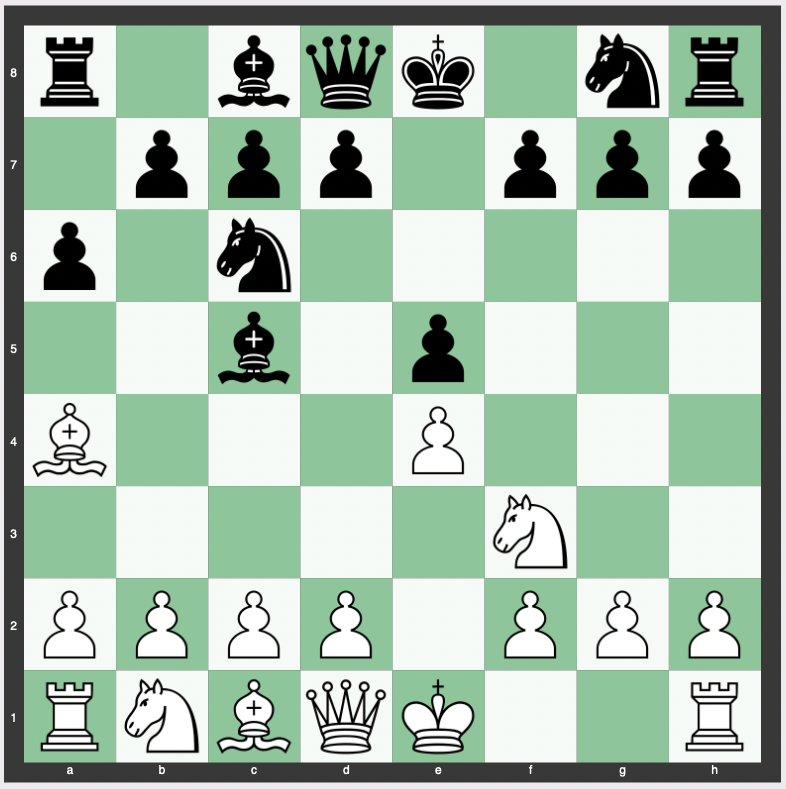Among the Ruy Lopez’s many variations, one of the more understated lines is the Classical Defense Deferred, specifically beginning with 1.e4 e5 2.Nf3 Nc6 3.Bb5 a6 4.Ba4 Bc5.
This variation is less common but equally rich in strategy and counterplay opportunities.
Often categorized as an “open game,” the Ruy Lopez and variations like the Classical Defense Deferred presents a broad spectrum of strategic options, from early pawn structure development to long-term maneuvering.
The article will delve into the intricacies of the Classical Defense Deferred of the Ruy Lopez, exploring its move order, theory, strategy, variations, historical significance, accessibility for beginners and intermediates, and its popularity among Grandmasters.
Move Order of the Classical Defense Deferred
The Classical Defense Deferred in the Ruy Lopez is a specific sequence that begins with 1.e4 e5 2.Nf3 Nc6 3.Bb5 a6 4.Ba4 Bc5.

Here, each move has a distinct purpose. The 1.e4 e5 establishes control over the center, which is a common principle in the opening.
The 2.Nf3 Nc6 move develops the knights, preparing them for future exchanges.
The 3.Bb5 pins the Nc6 knight, applying pressure to the black e5 pawn, and after 4…a6, the bishop retreats to a4, keeping the pin.
Finally, 4…Bc5 breaks from the more traditional …Nf6 move in the Ruy Lopez, shifting the game towards a less charted path.
Theory, Strategy, and Purpose of the Classical Defense Deferred
The theory behind the Classical Defense Deferred is to delay the development of the black’s king’s knight and instead, focus on developing the bishop to a more active square.
This strategy allows Black to target the weak f2 square early in the game.
On the other hand, white attempts to exploit the central pawn structure and develop rapidly for a kingside attack or potentially focus on the d4 advance.
The purpose of this particular variation is to sidestep the heavily analyzed main lines of the Ruy Lopez and steer the game into less explored territory where black can hope to catch white unprepared.
Variations of the Classical Defense Deferred
There are several possible continuations from the main line of the Classical Defense Deferred.
Some of the most noteworthy variations include the immediate 5.0-0, which emphasizes quick development and kingside safety, and the aggressive 5.c3 preparing for a d4 pawn thrust.
Black, meanwhile, could continue with 5…Nge7, planning to castle kingside or even consider …b5, pushing the white bishop further back and gaining space on the queenside.
The flexibility of this position means both white and black have a variety of ways to shape the middlegame.
History of the Classical Defense Deferred
Historically, the Ruy Lopez has been a preferred choice among world champions and top-level players due to its strategic depth and dynamic possibilities.
The Classical Defense Deferred, although less popular, has seen use in high-level games and continues to be an area of interest for players looking for less explored lines.
The move 4…Bc5 has a rich history, dating back to at least the 19th century, but gained substantial attention during the 1980s and 1990s when it was employed by several strong Grandmasters.
Is the Classical Defense Deferred Good for Beginners or Intermediates?
The Classical Defense Deferred of the Ruy Lopez could be a good choice for both beginners and intermediate players.
For beginners, it serves as a sound introduction to critical chess principles such as center control, piece development, and king safety.
For intermediate players, it offers a less-traveled path in the Ruy Lopez, enabling them to potentially exploit opponents who are unprepared for this variation.
However, the unique strategies involved require a deeper understanding of chess principles, and hence it may be challenging for novices.
How Often Is the Classical Defense Deferred Played at the Grandmaster Level?
While the Ruy Lopez is a frequent guest in Grandmaster games, the Classical Defense Deferred specifically is less common at this level.
Many top-tier players prefer the solidity of the main lines, which have been analyzed extensively over decades.
That said, this variation isn’t absent from high-level play. It is occasionally seen as a surprise weapon in tournament play or in situations where a player hopes to exploit an opponent’s lack of preparation in this specific line.
Conclusion
The Classical Defense Deferred in the Ruy Lopez is a captivating variation that presents an alternative strategic perspective on this storied opening.
While it does not enjoy the same mainstream attention as some of the more traditional Ruy Lopez lines, its rich historical roots and strategic depth make it a fascinating area of exploration.
Whether you’re a beginner learning basic chess principles, an intermediate player seeking uncharted terrain, or a Grandmaster looking to catch an opponent off guard, this underappreciated gem offers a wide range of strategic possibilities that can enhance your understanding and appreciation of the game of chess.


